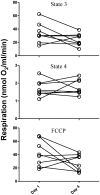Effect of short-term thyroxine administration on energy metabolism and mitochondrial efficiency in humans
- PMID: 22844412
- PMCID: PMC3406028
- DOI: 10.1371/journal.pone.0040837
Effect of short-term thyroxine administration on energy metabolism and mitochondrial efficiency in humans
Abstract
The physiologic effects of triiodothyronine (T3) on metabolic rate are well-documented; however, the effects of thyroxine (T4) are less clear despite its wide-spread use to treat thyroid-related disorders and other non-thyroidal conditions. Here, we investigated the effects of acute (3-day) T4 supplementation on energy expenditure at rest and during incremental exercise. Furthermore, we used a combination of in situ and in vitro approaches to measure skeletal muscle metabolism before and after T4 treatment. Ten healthy, euthyroid males were given 200 µg T4 (levothyroxine) per day for 3 days. Energy expenditure was measured at rest and during exercise by indirect calorimetry, and skeletal muscle mitochondrial function was assessed by in situ ATP flux ((31)P MRS) and in vitro respiratory control ratio (RCR, state 3/state 4 rate of oxygen uptake using a Clark-type electrode) before and after acute T4 treatment. Thyroxine had a subtle effect on resting metabolic rate, increasing it by 4% (p = 0.059) without a change in resting ATP demand (i.e., ATP flux) of the vastus lateralis. Exercise efficiency did not change with T4 treatment. The maximal capacity to produce ATP (state 3 respiration) and the coupled state of the mitochondria (RCR) were reduced by approximately 30% with T4 (p = 0.057 and p = 0.04, respectively). Together, the results suggest that T4, although less metabolically active than T3, reduces skeletal muscle efficiency and modestly increases resting metabolism even after short-term supplementation. Our findings may be clinically relevant given the expanding application of T4 to treat non-thyroidal conditions such as obesity and weight loss.
Conflict of interest statement
Figures



Similar articles
-
Growth hormone administration stimulates energy expenditure and extrathyroidal conversion of thyroxine to triiodothyronine in a dose-dependent manner and suppresses circadian thyrotrophin levels: studies in GH-deficient adults.Clin Endocrinol (Oxf). 1994 Nov;41(5):609-14. doi: 10.1111/j.1365-2265.1994.tb01826.x. Clin Endocrinol (Oxf). 1994. PMID: 7828350
-
Thyroid Function Variation in the Normal Range, Energy Expenditure, and Body Composition in L-T4-Treated Subjects.J Clin Endocrinol Metab. 2017 Jul 1;102(7):2533-2542. doi: 10.1210/jc.2017-00224. J Clin Endocrinol Metab. 2017. PMID: 28460140 Free PMC article.
-
Changes in sleeping and basal energy expenditure and substrate oxidation induced by short term thyroxin administration in man.Obes Res. 1996 May;4(3):213-9. doi: 10.1002/j.1550-8528.1996.tb00539.x. Obes Res. 1996. PMID: 8732955 Clinical Trial.
-
Thyroid hormones and thermogenesis: the metabolic cost of food and exercise.Metabolism. 1984 Mar;33(3):262-5. doi: 10.1016/0026-0495(84)90048-9. Metabolism. 1984. PMID: 6694567
-
Combination L-T3 and L-T4 therapy for hypothyroidism.Curr Opin Endocrinol Diabetes Obes. 2013 Oct;20(5):460-6. doi: 10.1097/01.med.0000432611.03732.49. Curr Opin Endocrinol Diabetes Obes. 2013. PMID: 23974776 Review.
Cited by
-
The role of thyroid hormone in metabolism and metabolic syndrome.Ther Adv Endocrinol Metab. 2020 May 13;11:2042018820917869. doi: 10.1177/2042018820917869. eCollection 2020. Ther Adv Endocrinol Metab. 2020. PMID: 32489580 Free PMC article. Review.
-
Winter Is Coming: Seasonal Variation in Resting Metabolic Rate of the European Badger (Meles meles).PLoS One. 2015 Sep 9;10(9):e0135920. doi: 10.1371/journal.pone.0135920. eCollection 2015. PLoS One. 2015. PMID: 26352150 Free PMC article.
-
Levothyroxine enhances glucose clearance and blunts the onset of experimental type 1 diabetes mellitus in mice.Br J Pharmacol. 2017 Nov;174(21):3795-3810. doi: 10.1111/bph.13975. Epub 2017 Sep 20. Br J Pharmacol. 2017. PMID: 28800677 Free PMC article.
-
Altered regulation of energy homeostasis in older rats in response to thyroid hormone administration.FASEB J. 2014 Mar;28(3):1499-510. doi: 10.1096/fj.13-239806. Epub 2013 Dec 16. FASEB J. 2014. PMID: 24344330 Free PMC article.
-
Aging under endocrine hormone regulation.Front Endocrinol (Lausanne). 2023 Aug 2;14:1223529. doi: 10.3389/fendo.2023.1223529. eCollection 2023. Front Endocrinol (Lausanne). 2023. PMID: 37600699 Free PMC article. Review.
References
-
- Leonard JL, Koehrle L. Braverman LE, Utiger RD, editors. Intracellular pathways of iodothyronine metabolism. 1996. pp. 125–161. Werner and Ingbar’s the thyroid: a fundamental and clinical text. Philadelphia: Lippincott-Raven.
-
- Dimitriadis G, Baker B, Marsh H, Mandarino L, Rizza R, et al. Effect of thyroid hormone excess on action, secretion, and metabolism of insulin in humans. Am J Physiol. 1985;248:E593–601. - PubMed
-
- Lovejoy JC, Smith SR, Bray GA, DeLany JP, Rood JC, et al. A paradigm of experimentally induced mild hyperthyroidism: effects on nitrogen balance, body composition, and energy expenditure in healthy young men. J Clin Endocrinol Metab. 1997;82:765–770. - PubMed
Publication types
MeSH terms
Substances
Grants and funding
LinkOut - more resources
Full Text Sources
Medical

